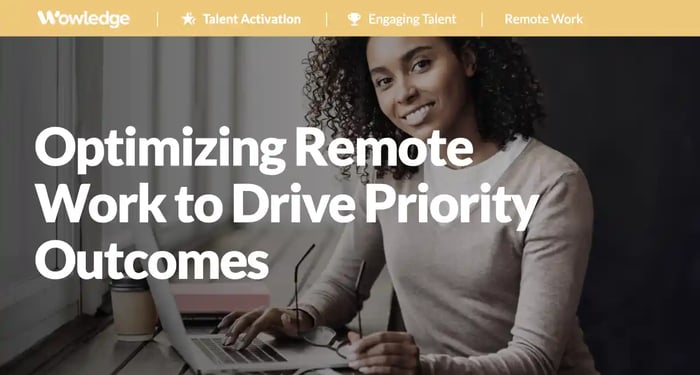The topic of remote work has been a headliner in both the popular and business press for several years, with billions (2,560,000,000 hits on Google) of articles, research, opinions, and commentary on its value, benefits, drawbacks, and guidance for employers and employees. Driven by approximately 3 ¼ years (2020-2023) of the global COVID-19 pandemic, the number of employees working remotely (outside of their employer’s facilities) rose and fell consistent with the severity of the illnesses’ spread. Lessons were learned during that time about optimizing remote work opportunities that benefitted both the employee and the organization.
However, the experience of workplace flexibility created an unprecedented appetite for increased location flexibility by workers. With the public health reasons for remote work largely passed, the portion of people working remotely worldwide has been estimated to be as high as 28% by 2023. While estimates of remote work in the U.S. vary and are certainly lower than during the peak of the crisis, a continuing pressure to increase its use and availability by employees and job candidates persists. That pressure for optimizing remote work is only increasing due to continuing labor shortages and low unemployment rates, combined with strong quit rates and high levels of preference for workplace and schedule flexibility among the predominant labor force participants.
While Gallup reports that 70+ million U.S. workers can perform their jobs remotely, many top leaders have second thoughts. Organizations struggle to find a balance for optimizing remote work that drives employee productivity, retention, innovation, and engagement while supporting a strong employer value proposition, brand, and candidate attraction position.
The realities of the situation
From the employee perspective
Abundant evidence exists that employees prefer flexibility in their work locations and schedules. For example, one study found that 97% of employees want to work remotely, either full- or part-time. They cite the benefits of fewer distractions (35% feel more productive at home) and a greater work-life balance (71%).
Gallup research similarly showed that employees with remote or hybrid work arrangements report a significantly improved work-life balance, more efficient work time, better control over their work hours and work location, improved mitigation of burnout, and higher productivity. Employees voice concerns over mandatory office attendance, specifically worried about their work-life balance, commuting costs, and increased stress. Probably most concerning is the increased likelihood of turnover. 57% of workers would look for a new job if their company didn’t allow remote work. Optimizing remote work creates an opportunity to improve their experiences and address their concerns.
However, employees see the downsides to the remote work situation, with 53% finding it isolating and thus more challenging to build advantageous relationships with co-workers. They report feeling regret over missed in-person meetings and other office activities. Their control over work hours may not be as hoped, with 55% stating they work more weekly.
Employees further demonstrate their understanding of the benefits of a balanced approach to remote work. Conference Board research showed that employees agreed with the rationale that onsite work:
- Boosts networking and peer relationship building
- Increases work collaboration
- Maintains the organizational culture
- Having a safe workplace with appropriate protocols in place
- Enhances a culture of innovation/creativity
- Increases personal development, mentorship, and career development opportunities
- Increases work productivity
From management’s perspective
Trust is an enormous issue for leaders and managers. Many managers have not yet adapted to this new reality and are uncomfortable with the inability to oversee employees at work. 82% of remote managers worry about reduced productivity, and 30% of business leaders voice concerns about maintaining the corporate culture with so many employees working remotely.
One study showed that management teams who preferred requiring employees in the office were most concerned about improving productivity, co-worker relationships and collaboration, employee focus, and accountability. It should come as no surprise that 60% of companies use employee monitoring software to monitor remote workers (with other research suggesting it is as high as 96% in remote companies), and 73% of managers are concerned about the security risks inherent in the digital nature of remote work.
Data supporting the value of in-person, on-site work may bolster this view of management. Companies in a survey reported improved collaboration (65%), employee relationships (59%), productivity (47%), and accountability (47%) when their employees are in the office. Optimizing remote work creates opportunities to bridge the benefits of both work location and scheduling approaches.
Plus, there is an upside to this trust issue, with over 61% of leaders having more frequent check-ins with their remote employees. As a best practice in performance management and employee engagement, it is also responsive to the strong preferences of over 60% of the working population, which is made up of Millennials and GenZ workers, who report regular contact and coaching with a manager as high-priority drivers of their satisfaction and engagement.
The availability and use of remote work
Data reports of the number of workers in remote jobs vary widely, but many companies are allowing some level of work away from their official organizational facilities. However, not all employees can work from home—especially in manufacturing products or customer-facing industries, including transportation, health care/hospitals, restaurants, hotels, and retail establishments.
As many as 41% of workers cannot work remotely based on the nature of their work or the employer’s insistence on working at company locations. Clarifying this further, 82% of industrial and manual services workers must work in company facilities designed and appropriate for that type of output.
That said, Gallup reports that 50% of workers engaged in “remote-capable jobs” do so on a partial-to-full-time basis. Pew Research found that as many as 76% of employees who can perform their work offsite do so on either a full-time (35%) or hybrid (41%) basis. Others reported similar findings, with 58% of those able to work on either a full-time (35%) or part-time (23%) basis or 49% total working either at home full-time (12.7%) or splitting their workweeks between home and office part-time (28.2%).
The hybrid model is becoming the preferred solution
All the preceding discussions lead us to an inescapable conclusion – based on 1) the benefits and shortcomings of remote work, 2) the strong preferences of workers, and 3) the goals of the organizations who seek to attract, hire, and retain them are driving organizations to adopt a hybrid work location and scheduling model where possible. Optimizing remote work by balancing employee (and candidate) preferences and the organization's is essential in dealing with these circumstances. What is an open question is the onsite/remote model to be adopted, with three primary options:
- Designated in-office days and hours applied to the entire organization with common/”core” hours while adhering to a minimum 40-hour work week
- Designated minimum number of days, with employee or work unit decisions on which days and common work hours each week
- Flexible scheduling left up to the individual or work unit based on business or project requirements
McKinsey found that 87% of remote-capable work duties spend an average of three (3) days a week working from home. That appears to be the most common iteration of these policies. Other studies show that 41% of those employees can set their own schedule, 28% must come in on commonly required days, and 22% can choose their days but are held to a common minimum number. Yet another study found that 46% have flexibility around a core set of hours or complete freedom to decide the work hours and days they perform their tasks.
It is also seen that the hybrid model is somewhat more common in larger organizations (with more than 1000 employees) than in smaller ones (with less than 100 employees). Not surprisingly, this appears to be based on need (more geographically dispersed employees, more real estate savings opportunities), and better resourcing (being able to afford supporting technologies, bigger scale allowing for more savings opportunities).
The reasons why organizations are open to remote work
Regardless of management’s preferences for a return to the “old norm,” the reality is that there are business benefits that add to the leverage that workers hold (and presumably will continue to) in the job market, driving changes in thinking by leaders. Real benefits and self-preservation combine to make a solid business case for creating an ecosystem capable of optimizing remote work for those employees whose tasks can be performed in a mixed onsite/offsite manner.
Reports of inflexible return to work (RTW) policies have shown that 71% of organizations who require RTW have much greater difficulty retaining workers than others who provide flexibility by giving employees a choice or the ones who have not implemented a formal policy. Furthermore, those companies who fear worsened talent outcomes from remote work are countered by studies such as one by Stanford University, which found remote workers were 13% more productive than onsite peers, less likely to use sick days, and more likely to report higher job satisfaction.
Companies report advantages concentrated on cost savings, risk avoidance, and positive talent outcomes from their workforces. For example, it is estimated that an average employer can save $11,000 per year per half-time telecommuter based upon savings from lost productivity, retention, real estate requirements, transit subsidies, and reduced absenteeism.
Other key reasons for adopting the approach to optimizing remote work include access to broadened talent pools (cited by 80% of companies), enhanced talent attraction and retention (77%), real estate and equipment savings (42%), improved employee mental health (37%), and increased productivity (30%). Other key benefits cited are maintaining an organizational culture, facilitating collaboration, and real estate investments, among the leading reasons driving flexible return-to-office mandates worldwide in 2023.
On the talent engagement and retention front, a compelling statistic is that 80% of employees reported that they would be more loyal to companies offering flexible work schedules.

Three primary issues and challenges with remote work
Organizational readiness and managerial skills
Interesting observations are coming out about the effectiveness of enterprise implementations of remote work policies and practices. For example, 75% of companies have not yet trained their managers to lead remote teams after four years of allowing remote work. They have not defined team norms, established standards for running mixed onsite/offsite employee meetings, or adopted best practices for leading teams across geographic and time zone boundaries. This lack of guidance and a strategy for optimizing remote work is shocking, given how common such work arrangements already are.
Gallup has found that the manager drives much of remote work arrangements' success (or failure). In fact, it reports that 73% of hybrid managers and senior leaders are unprepared to lead hybrid teams. This is especially significant in that a manager’s effectiveness is four times (4X) more important than the employee's work location in determining their level of engagement and well-being. Developing them is, therefore a primary (and critical) opportunity for optimizing remote work and enjoying its myriad benefits.
Managing turnover
Data on the relative value of offering remote work from a turnover perspective is mixed. It appears that when flexibility is offered and well-executed, it significantly increases employee retention with such options. This seems to be based on how many workers are fully remote versus working a hybrid schedule.
For example, a study by Paychex found that remote employees were 117% more likely to look for another job than their onsite peers based on poor onboarding experiences, lack of training for the new job, and feeling devalued after onboarding.
Similarly, other research found higher turnover (20%) by fully remote workers than their hybrid or full-time office peers (11.9%), suggesting that a hybrid model, which offers the benefits of both remote and in-office work, maybe the superior model. According to the Harvard Business Review, while 62% of employees believe remote work improves their engagement, only 5% intend to stay in their jobs long-term. These findings may be due to remote work opportunities not matching their managers’ skills and capabilities to keep them motivated, developed, and feeling like part of the team.
On the other hand, much more research is finding that remote work offerings lead to higher retention. Gallup found that hybrid workers enjoy significantly better engagement rates, well-being, and lower intentions to leave than their fully on-site, remote-capable peers. Remote workers are 32% less likely to leave their jobs, while the inability to work outside the office is associated with a 14% increase in intent to leave. Other studies are making similar observations, with turnover differences between 25% to 50% lower.
Managing organizational culture and engagement
Challenges abound with managing a workforce with mixed schedules and locations. While allowing employees flexibility in their work location can drive higher engagement, retention, and lower stress/burnout, there is a trend towards decreased (28%) remote worker connections to the organization's mission and purpose. As this is a key driver of positive talent outcomes, it should be a concern.
Similarly, 32% of hybrid workers report a lower connection to their company culture, a likely outcome of working in an isolated environment. Indeed, building and maintaining a culture is more challenging in a remote work environment, given the lack of personal connections and relationships built in an in-person environment. Being deprived of close contact seems to negatively impact the formation of trust, connection, and mutual purpose essential to collaborative work. And 41% of remote employees reported difficulties in fitting into a company culture, an issue particularly problematic with increasingly diverse workforces.
Key steps to take to build a strong remote work environment
1. Hire remote-ready employees
Optimizing remote work should start with leveraging enhanced hiring standards for remote-capable roles, including technical skills, cultural fit, and remote competencies/skill sets. While successful remote workers' skills tend to be more embedded in their work style, some can be refined and developed further. Key success skills/capabilities include strengths in written and spoken communications (for asynchronous and virtual exchanges), time management, discipline and reliability (for initiating and completing assignments), goal orientation, digital literacy, and teamwork/collaboration. Candidate assessments should include these at the screening, interviewing, testing/assessment, and reference-checking steps of the hiring process.
2. Onboarding for cultural, developmental, role orientation
As has been shown, a robust and comprehensive onboarding experience is a significant determinant of remote new hire success, satisfaction, and readiness to contribute. Given their partial or total absence from the physical office, team members, and direct manager, deep connections to their work purpose, performance expectations, coaching, teammates, and development must be established and maintained from day one.
Immediate and regular direction from their manager, access to all needed equipment and online resources (knowledge management portal, workflow documentation, collaboration apps, etc.), and planned connection opportunities with mentors and tenured co-workers should be scheduled and structured. Planned opportunities for travel to central or regional sites for structured learning, collaboration events, network building, and exposure to top leaders should be required.
3. Outline and plan training and development opportunities
Skill development has obvious benefits for organizations, with higher engagement and performance, leaving employees 39% more likely to feel productive and successful and 23% more likely to accept more responsibilities. As remote workers bring unique challenges (varying time zones, connectivity, distractions at home, no “hallway” exchanges and questions with peers, etc.), providing meaningful development that drives productivity, retention, and engagement can be difficult but essential for optimizing remote work.
The availability and support for their growth are essential, and as such, new hire development plans are key to new hires’ early engagement and satisfaction, with a focus on 1) immediate job skill and knowledge gap closure, 2) new tool and methodology awareness and skill building, and 3) potential future role capability development.
Offerings for blended (e.g., eLearning with live follow-up sessions) learning, especially in a cohort with peers, provide chances to learn with others, receive feedback, share best practices, and build relationships with co-workers. Given estimates that informal learning decreased by 25% during the pandemic, a powerful opportunity exists to improve remote learning through increased virtual mentoring, group coaching, buddy systems, and online collaboration tools and forums (Slack, MS Teams, Google Docs, Trello, Zoom).
4. Manage onsite days effectively
In a hybrid environment, it is essential that in-office days are meaningful and motivating for employees to attend. Consider the work that can be accomplished synchronously (with others) and asynchronously (alone), and schedule work best conducted together. Employees generally do not like attending meetings, so manage their frequency and length. Make the days “intentional” with collaboration, development, coaching, and team-building opportunities.
Going further, bring partner teams/functions together by creating cross-functional work and learning events (business problem solving, manager development, coding/hackathons, customer feedback, etc.) where colleagues cross departmental lines to learn and contribute to resolving challenges together. Why is this important? To overcome the challenge that remote work may stifle innovation, such as the significant drops (38%) in collaboration with workers outside one’s department or function.
5. Prioritize managerial skill development
Research from Gallup found that remote employees interact less with their managers when working at home, meaning they receive less guidance, coaching, feedback, and development than those working onsite. Given the paucity of remote management training offered and the manager’s lack of confidence and skill mentioned earlier, this is a paramount concern. Skills in asynchronous communications, meeting management, setting expectations, providing feedback, encouraging teamwork, recommending people to connect with, and recognizing contributions and “wins” are extremely important for remote managers. Requiring them to conduct effective weekly check-ins and regular communications with their direct reports should be a policy and required duty.
Leverage group coaching, dedicated collaborative (e.g., Slack) channels, and mentoring to develop and continuously reinforce the constructive management skills required for success. Pulse surveys are used to get candid employee feedback on their managers, and the data is used for rewards, recognition, and remedial development.
Relevant Practices & Tools
Providing Frequent Coaching and Feedback to Adapt and Adjust Performance Throughout the Year. >
Coaching & Mentoring is an employee development activity that, in the context of performance management, involves a manager providing feedback and guidance on an ongoing basis... more »
Incorporating Coaching and Mentoring into Performance Management to Better Engage Employees in their Own Performance. >
Enhancing managerial feedback and coaching is a process informed and driven in part by training and development, in part through feedback, and in part by reinforcement... more »
Conducting Development Planning to Establish Business-aligned Learning for Each Employee. >
Development planning engages the employee and functional manager in a discussion of individual strengths, ambitions, and work preferences relative to company direction... more »
Developing Leaders Across Multiple Levels of Management. >
Advanced leadership development is designed to not only develop current executives, but "leaders" in all levels of the organization... more »
The Career Development Plan Tool: Prepare for Potential New Roles by Identifying Actions to Close Related Skills and Relationships Gaps. >
A template that first helps identify the main goal(s) of an executive when considering their next move. Based on these goals, it helps define possible positions and companies as a next move... more »
About Wowledge
Wowledge is the expert-driven platform for lean teams building strategic HR programs. Members enjoy access to up-to-date best practices, step-by-step guides, tools, templates, and insights to accelerate the design and implementation of all key HR programs and processes.
Since each organization has unique characteristics, needs, and aspirations, Wowledge's practices are developed utilizing an exclusive stage-based approach – from Core to Advanced to Emerging – that reflects distinct levels of sophistication to meet our members where they are.
Build strategic HR programs with refreshingly easy-to-follow best practices.
Get started for FREE! Learn more.










